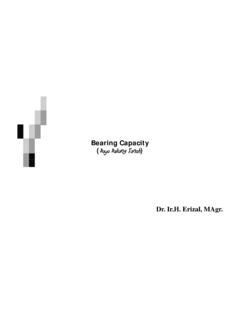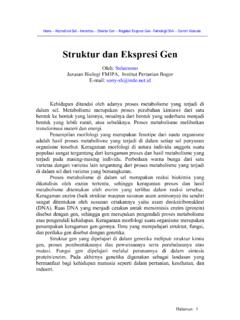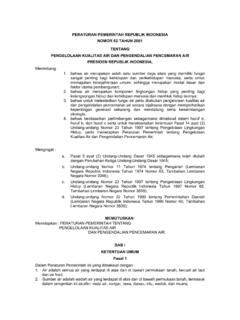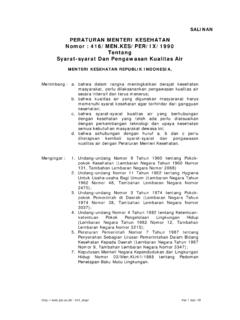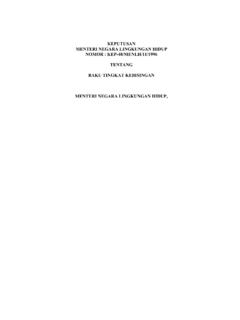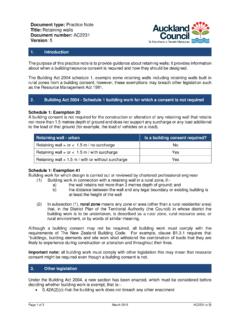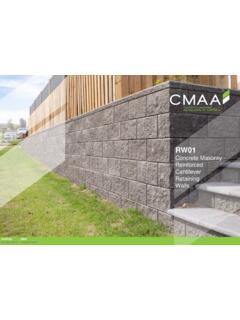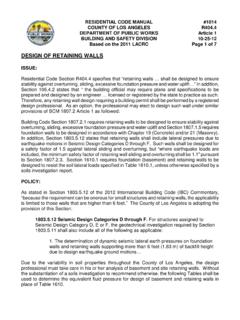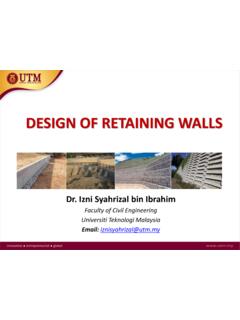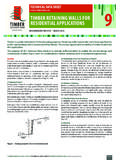Transcription of SIL211 MEKANIKA TANAH, 3(2-3) DESIGN AND DETAILING OF ...
1 SIL211 MEKANIKA TANAH, 3(2-3). DESIGN AND DETAILING OF retaining walls . DR. IR. ERIZAL, MAGR. DEPARTEMEN TEKNIK SIPIL DAN LINGKUNGAN. FAKULTAS TEKNOLOGI PERTANIAN. IPB. DESIGN AND DETAILING . OF retaining walls . Learning Outcomes: After this class students will be able to do the complete DESIGN and DETAILING of different types of retaining walls . 2. retaining WALL. GL2. retaining walls are usually BACK. built to hold back soil SOIL. mass. However, retaining walls can also be constructed GL1. for aesthetic landscaping purposes. Gravity retaining wall 3. Cantilever retaining wall with shear key Batter Drainage Hole Toe 4.
2 Photos of retaining walls 5. Classification of retaining walls Gravity wall- masonry or Plain concrete Cantilever retaining wall-RCC. (Inverted T and L). Counterfort retaining wall-RCC. Buttress wall-RCC. 6. Classification of retaining walls Backfill Backfill Tile Gravity RW drain L-Shaped RW. T-Shaped RW. Backfill Counterfort Buttress Weep hole Counterfort RW Buttress RW. 7. Earth Pressure (P). Earth pressure is the pressure exerted by the retaining material on the retaining wall. This pressure tends to deflect the wall outward. GL. Types of earth pressure : Active earth pressure or earth pressure (Pa) and Pa Passive earth pressure (Pp).
3 Active earth pressure tends to deflect the wall away from the backfill. Variation of Earth pressure 8. Factors affecting earth pressure Earth pressure depends on type of backfill, the height of wall and the soil conditions Soil conditions: The different soil conditions are Dry leveled back fill Moist leveled backfill Submerged leveled backfill Leveled backfill with uniform surcharge Backfill with sloping surface 9. Analysis for dry back fills Maximum pressure at any height, p=ka h GL. Total pressure at any height from top, pa=1/2[ka h]h = [ka h2]/2 h H. Bending moment at any height GL Pa M=paxh/3= [ka h3]/6.
4 M. Total pressure, Pa= [ka H2]/2. Total Bending moment at bottom, ka H. M = [ka H3]/6 H=stem height 10. Where, ka= Coefficient of active earth pressure = (1-sin )/(1+sin )=tan2 . = 1/kp, coefficient of passive earth pressure = Angle of internal friction or angle of repose =Unit weigh or density of backfill If = 30 , ka=1/3 and kp=3. Thus ka is 9 times kp 11. Backfill with sloping surface pa= ka H at the bottom and is parallel GL. to inclined surface of backfill ka= cos cos 2 cos 2 . cos . cos cos cos . 2 2. Where =Angle of surcharge Total pressure at bottom =Pa= ka H2/2. 12. Stability requirements of RW.
5 Following conditions must be satisfied for stability of wall (IS:456-2000). It should not overturn It should not slide It should not subside, Max. pressure at the toe should not exceed the safe bearing capacity of the soil under working condition 13. Check against overturning Factor of safety against overturning = MR / MO (= ). Where, MR =Stabilising moment or restoring moment MO =overturning moment As per IS:456-2000, MR> MO, ch. DL + MO, ch. IL. MR MO, ch IL. 14. Check against Sliding FOS against sliding = Resisting force to sliding/. Horizontal force causing sliding = W/Pa (= ). As per IS:456:2000.
6 = ( W)/Pa Friction W. SLIDING OF WALL. 15. DESIGN of Shear key In case the wall is unsafe against sliding pp= p tan2 (45 + /2). = p kp H where pp= Unit passive pressure on soil above H+a shearing plane AB. PA p= Earth pressure at BC. C R=Total passive A R pp resistance=ppxa a . B W ka (H+a). =45 + /2. 16. DESIGN of Shear key-Contd., If W= Total vertical force acting at the key base = shearing angle of passive resistance R= Total passive force = pp x a PA=Active horizontal pressure at key base for H+a W=Total frictional force under flat base For equilibrium, R + W =FOS x PA. FOS= (R + W)/ PA 17. Maximum pressure at the toe W4 H.
7 X1 W1. h W. W2. x2 Pa R. H/3. W3. T. e b/6. x b/2. b Pmin. Pressure below the Pmax retaining Wall 18. Let the resultant R due to W and Pa lie at a distance x from the toe. X = M/ W, M = sum of all moments about toe. Eccentricity of the load = e = (b/2-x) b/6. W 6e . Minimum pressure at heel= Pmin 1 b >Zero. b For zero pressure, e=b/6, resultant should cut the base within the middle third. Maximum pressure at toe= W 6e . SBC of soil. Pmax 1 b . b 19. Depth of foundation Rankine's formula: 2. Df =. SBC 1 sin . 1 sin .. SBC 2 Df = ka .. 20. Preliminary Proportioning (T shaped wall). 200. Stem: Top width 200 mm to 400 mm Base slab width b= to , to for surcharged wall Base slab thickness= H/10 to H/14 H.
8 Toe projection= (1/3-1/4) Base width H/10 . tp= (1/3-1/4)b H/14. b= to 21. Behaviour or structural action Behaviour or structural action and DESIGN of stem, heel and toe slabs are same as that of any cantilever slab. 22. DESIGN of Cantilever RW. Stem, toe and heel acts as cantilever slabs Stem DESIGN : Mu=psf (ka H3/6). Determine the depth d from Mu = Mu, lim=Qbd2. DESIGN as balanced section or URS and find steel Mu= fy Ast[d-fyAst/(fckb)]. 23. Curtailment of bars Effective depth (d) is Proportional to h Dist. from Bending moment is h1 top Every alternateproportional to h3. Ast/2 h2 bar cut h1c Ast is l to (BM/d) and is Ldt l to h2.
9 Ast h2 Ast1 h12. 2. Ast/2 Ast Ast 2 h2. Provided Ast Cross section Curtailment curve 24. DESIGN of Heel and Toe 1. Heel slab and toe slab should also be designed as cantilever. For this stability analysis should be performed as explained and determine the maximum bending moments at the junction. 2. Determine the reinforcement. 3. Also check for shear at the junction. 4. Provide enough development length. 5. Provide the distribution steel 25. DESIGN Example Cantilever retaining wall DESIGN a cantilever retaining wall (T type) to retain earth for a height of 4m. The backfill is horizontal. The density of soil is 18kN/m3.
10 Safe bearing capacity of soil is 200 kN/m2. Take the co-efficient of friction between concrete and soil as The angle of repose is 30 . Use M20 concrete and Fe415 steel. Solution Data: h' = 4m, SBC= 200 kN/m2, = 18 kN/m3, = , =30 . 26. Depth of foundation To fix the height of retaining wall [H]. 200. H= h' +Df Depth of foundation h1 h H. 2. SBC 1 sin . Df = 1 sin . Df b = say , Therefore H= 27. Proportioning of wall Thickness of base slab=(1/10 to1/14)H 200. to , say 450 mm Width of base slab=b = ( to ) H H=5200 mm to say 3m tp= 750 mm Toe projection= pj= (1/3 to )H 450. 1m to say b= 3000 mm Provide 450 mm thickness for the stem at the base and 200 mm at the top 28.
